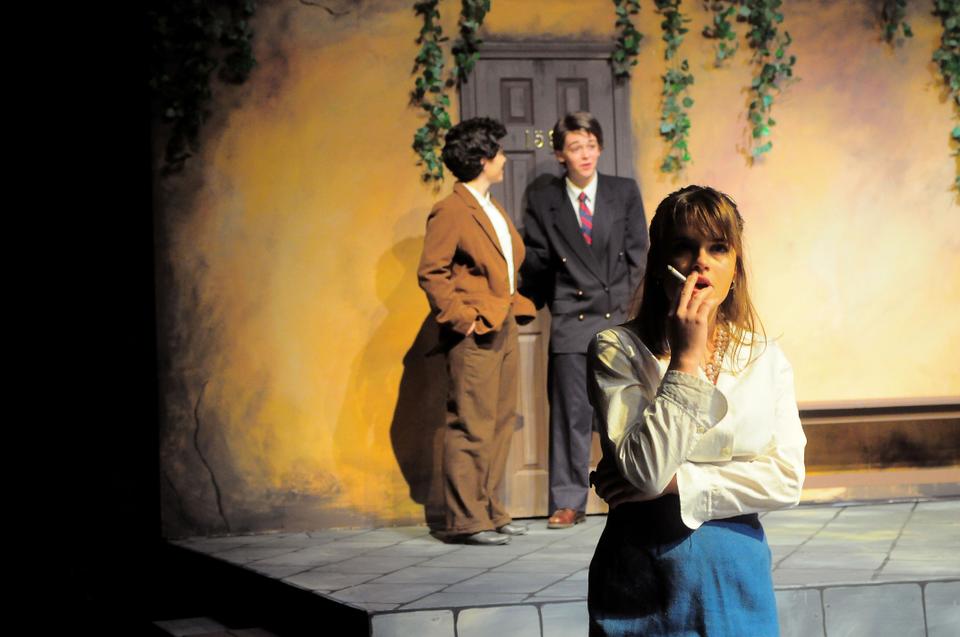
News
Summers Will Not Finish Semester of Teaching as Harvard Investigates Epstein Ties

News
Harvard College Students Report Favoring Divestment from Israel in HUA Survey

News
‘He Should Resign’: Harvard Undergrads Take Hard Line Against Summers Over Epstein Scandal

News
Harvard To Launch New Investigation Into Epstein’s Ties to Summers, Other University Affiliates

News
Harvard Students To Vote on Divestment From Israel in Inaugural HUA Election Survey
'Shrew' Recasts the Bard Anew
"The Taming of the Shrew" features an all female cast, and examines the play's traditional gender roles.

Can a play that features an exclusively female cast, regardless of the nature of the roles in the script, be about anything beside gender? Addressing this issue was the task that director Simone E. Polanen ’14 took on when she decided to use only female actors for the Harvard-Radcliffe Dramatic Club’s current production of “The Taming of the Shrew,” which runs at the Loeb Ex until November 3. By having an all-female cast in this misogynistic piece, the production turns traditional sexual norms on their head. Inconsistent acting brings a level of ridiculousness to the show that downplays the narrative of the work and instead focuses entirely on the production’s unique take on gender dynamics.
The play centers on the two daughters of Baptista (Emilie G. C. Thompson, ‘16)—the elder Bianca (Anna A. Hagen, ‘15), beautiful, sweet, and the perfect image of everything feminine, and the younger Katherina (Ema H. Horvath ’16), angry and defiant. Baptista will not allow his older daughter to marry any of her many suitors until a husband has been found for Katherina. The catch, of course, is that no one wants to marry her—that is, until Petruchio (Olivia L. Ball ’14) comes to town. As Petruchio is faced with “taming the shrew,” as it were, all of Bianca’s various suitors are plotting against each other and causing general chaos.
The set is simple, and the setting—post-World-War-II America—doesn’t add much to the play. The jazz music between scenes seemed slightly unnecessary. On the whole, the technical aspects were not particularly memorable; at times they were even sloppy. Transition music came in during the middle of scenes, and set changes were poorly organized, both boring and distracting the viewer.
However, the acting partially redemed the show. Horvath and Ball, as the leading couple, do a truly tremendous job of portraying their characters. Ball surpasses the gender barrier between herself and her role, not by becoming masculine in affect, but rather with subtle eyebrow flicks and sincere amusement. She delivers her monologue at the end of Act 1 sitting by herself on a trunk with legs apart—but not too much. She brings out the insidious political subtexts in the speech, adding new-found depth to her character. Her gender actually became a non-issue. Horvath, too, easily surpasses the other actresses, jutting out her chin and stomping around in heels. She really shines during the scenes where she is being “tamed.” She is able to communicate this transition with nuance and restraint: during a scene where Petruchio offers her a hamburger—an implicit symbol of his dominance—her body language conveys the inner conflict between independence and submission.
However, it is not always possible to believe the rest of the characters. The oversized jackets, wigs, and hats distracted from the acting in many cases, and as none of the actresses disguised their voices there was never any chance to forget these character’s gender duality. Many of the actress es struggle to convincingly portray men. On some level, that was part of the point of the show. However, in many cases it was distracting. In one scene where all the male characters were onstage, what could have been a Shakespearean bro-fest fell short as all of the actresses seem to be performing caricatures as opposed to realistic portrayals of men.
When Petruchio enters for his wedding to Katherina wearing a bright yellow suit with rhinestones, the absurdity really escalates. The second act serves to mock the sexist nature of the play. The balance between outrageous scenes and plain scenes is fairly well struck, and the production focuses on exploring gender relations even during the show’s most ridiculous moments. At every turn, though, the all-female cast emphasizes the absurdity of traditional gender roles at the cost of the narrative.
The directing was generally smart. Once Petruchio tamed Katherina, she takes off her heels and walked barefoot. A simple directing choice, but powerful in its simplicity, this moment has something that the rest of the play doesn’t—quiet. Filled with loud, boisterous scenes, raging screams at entrances and exits, and incredibly rapid dialogue, the play really gained strength at moments of relative calm.
Neither Ball nor Horvath transcended their gender entirely—nor did any other actress. Gender simply became an inverted concept and because of its ubiquity this switch lost its power in this production. Precisely because of its consistent presence in how one views the play, gender bending becomes the takeaway from the show.
Want to keep up with breaking news? Subscribe to our email newsletter.
